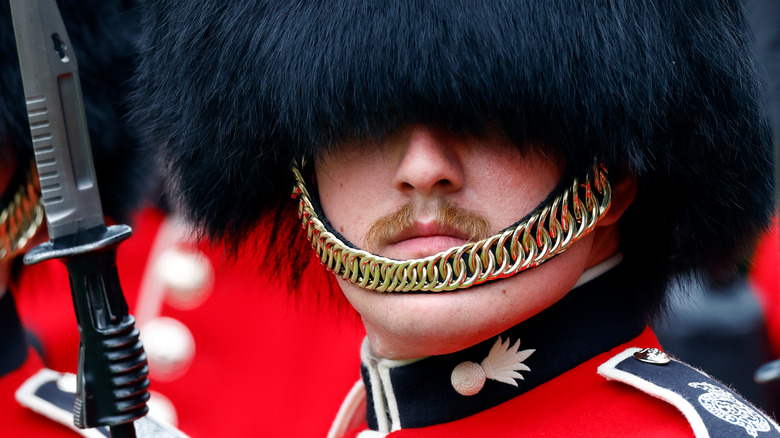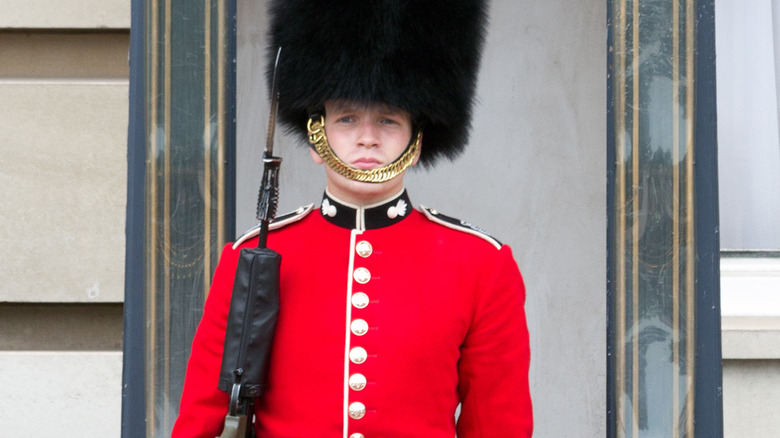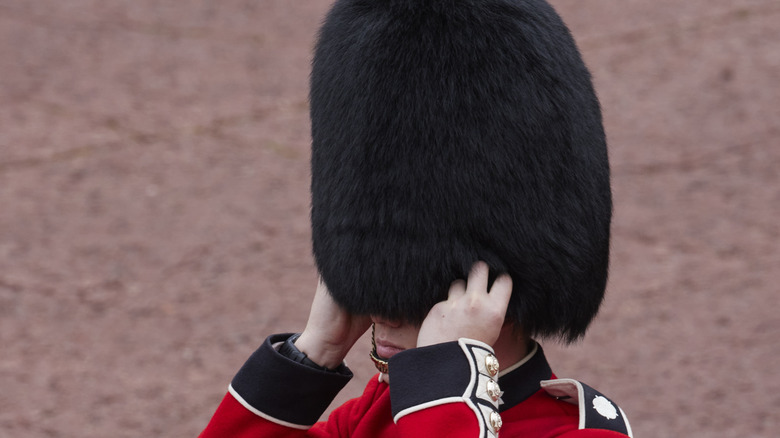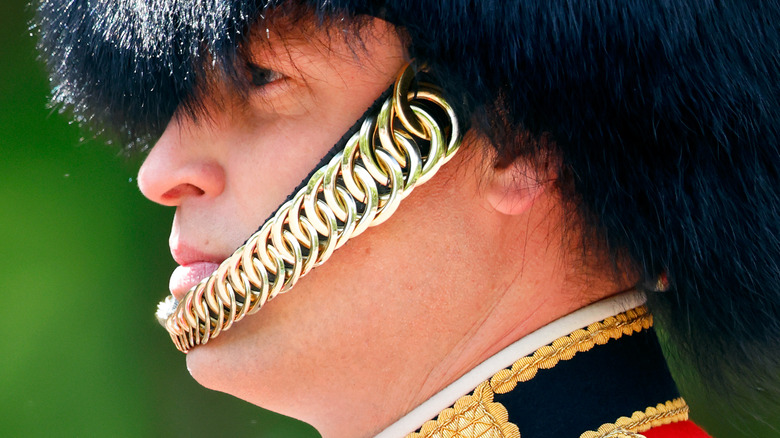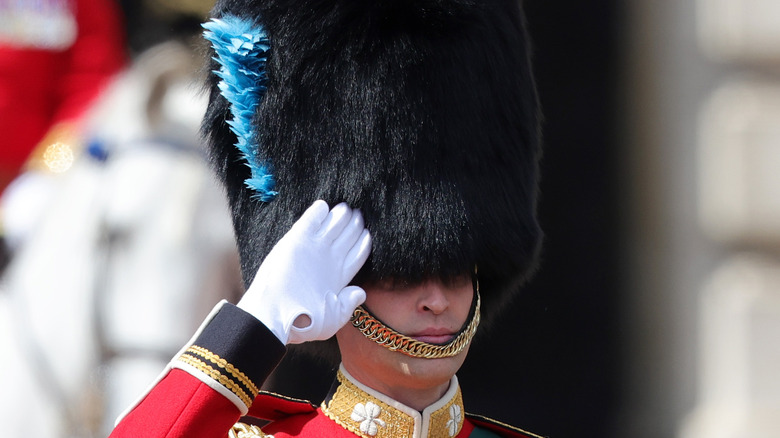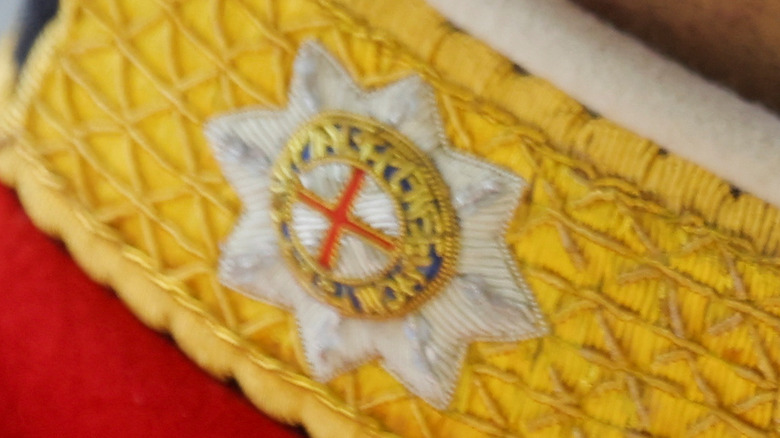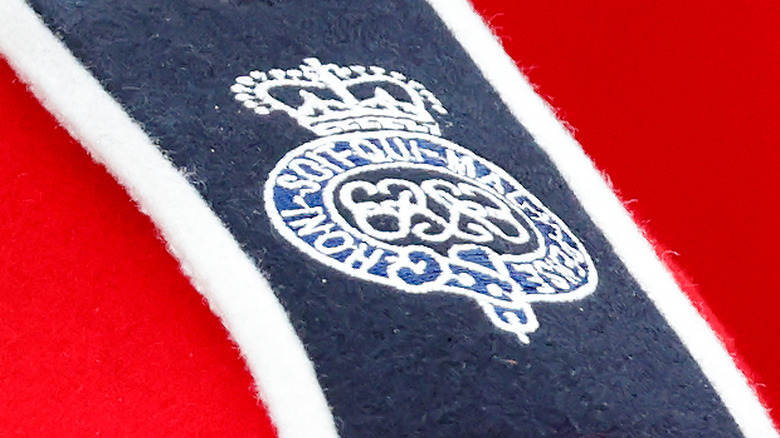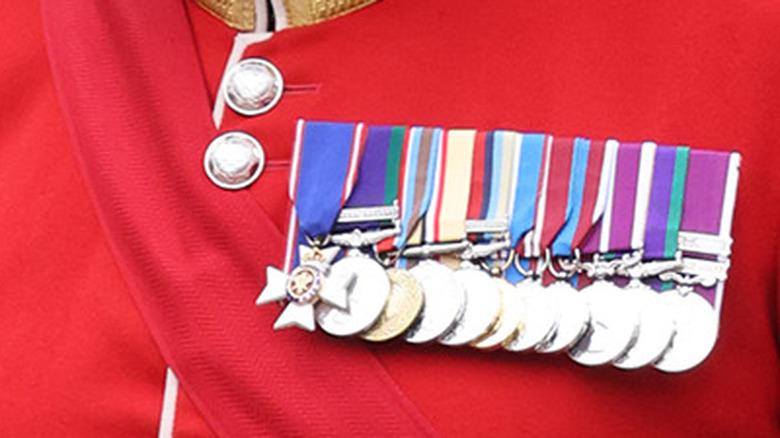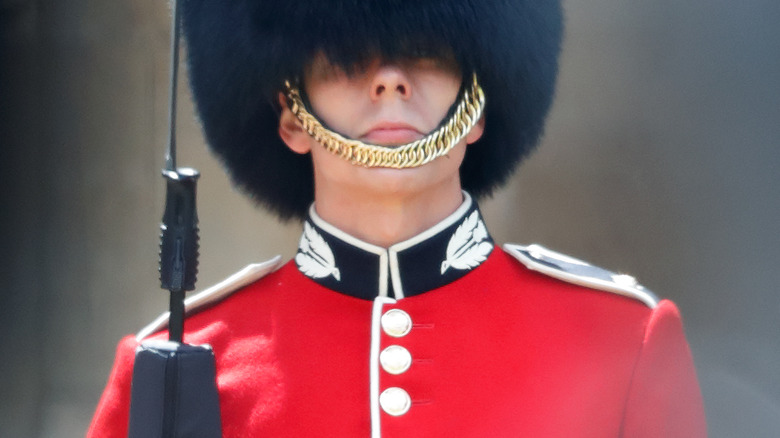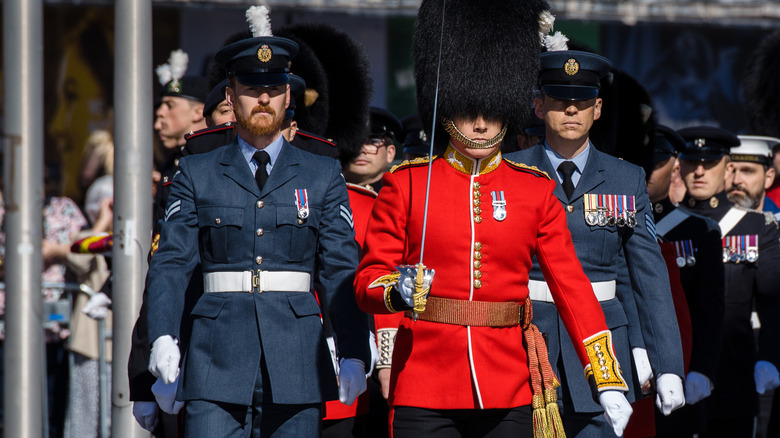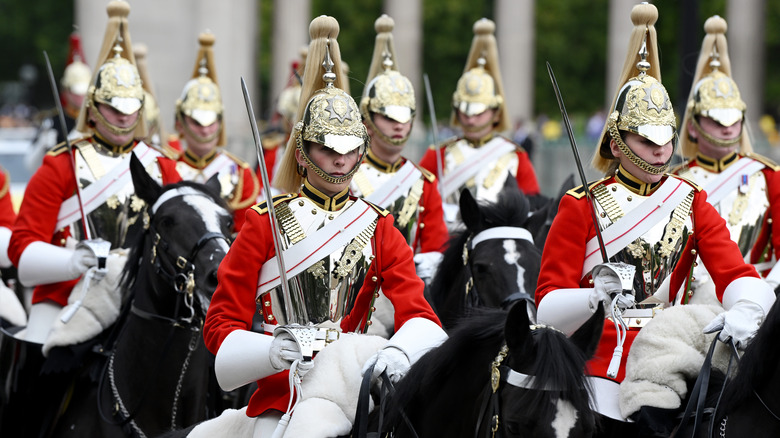Every Element Of The British Royal Guards Uniform Explained
The funeral of Queen Elizabeth II, as somber an occasion as it was, also acted as a display for all the pageantry of state that the United Kingdom can still muster. The empire may be gone and the powers of the monarchy greatly reduced, but the livery, coats of arms, swords, and uniforms worn under oath to the crown endure. The creation and maintenance of all this finery is an expensive and careful art, as Vogue detailed ahead of the funeral.
But it isn't necessary to wait for a state occasion to see an example of British dress uniforms. At least one of these outfits is a regular presence in London, guarding Buckingham Palace — it's those tall-hatted redcoats, the British royal guards. With origins stretching back to the exile of Charles II in 1658, according to the National Army Museum, the contingents have had an illustrious military history beyond their current claim to fame as a piece of popular ceremony. Members can still see active duty to this day.
Of course, no soldier in the midst of combat is going to wear a bearskin hat and a red jacket in this day and age; those are reserved for ceremonial functions. But those fancy uniforms weren't designed for show alone. The various pieces of the King's and Life Guard uniforms reflect its history and service. Here are the elements of the royal guard uniform, explained.
The red uniform covers up blood (allegedly)
In modern warfare, the idea of wearing a bright red jacket seems absurd. It offers no camouflage and presents an easy target to enemy fire. But war hasn't always been fought by today's standards. In the days of line infantry and battle outfits designed for identification more than disguise (per the Atlantic), red uniforms set English and British forces apart. And, in the event of injury, the jackets would mask any soldier's bleeding wound.
That, at least, is a popular legend about the red jackets, still passed among the King's Guard themselves, according to an interview by Insider. But the color may not have had as martial a reason for being. LiveScience took a look into the legend of the red jackets and concluded the legend of hiding blood was just that. Royal commentator Richard Fitzwilliams told them that the real reason for the crimson color was money; red dye was cheap and easy to get a hold of.
These days, other colors may be easier to come by, but the traditional scarlet is still maintained by the royal guards. You can see the guards in their red jackets unobscured every summer. If you happen to be in London during the winter months, those jackets are hidden under long gray coats.
The bearskin hats were for intimidation
Probably the single most distinguishing feature of the royal guards is those tall fur hats. Their proper name is bearskins, and that's exactly what they're made out of. The fur is sourced, according to LiveScience, from an annual cull of Canadian black bears done for population control. Though the bears aren't killed just to make the hats, and the British army only buys up to a 100 hats a year (at a cost of £650 each), as per the Tatler, the practice is still controversial. The government has mulled over finding a substitute since Brexit was finalized.
Bearskins aren't exclusive to the British. They were a common feature on the uniforms of gunners of both Britain and France during the Napoleonic wars (per iNews). As the soldiers most likely to directly engage in combat, commanders on both sides wanted to increase their troops' sense of menace. The bearskins added a few inches to each soldier, making them seem taller and more threatening to the opposing forces. And Napoleon, like the British crown, put the bearskins on all of his imperial guards.
French bearskins became appealing trophies for the victorious Brits after the Battle of Waterloo. These are not the hats currently worn by the British guards. But a well cared for bearskin can see a lot of use in its lifetime; according to Age of Revolution, they can last decades.
The straps around their lips are for safety
The most immediately noticeable feature of the royal guards' iconic bearskin hat is the silhouette it creates. But another detail that catches the eye is the way the hat is held onto the head. Instead of fitting under the chin, the gold chain straps for the bearskins fit under the guards' lips. On a uniform that can already be difficult to wear under certain conditions — as Insider notes they can be a bit much in heat – this seems a strange and uncomfortable requirement. But believe it or not, the lip strap once had a practical function.
According to Wales Online, the bearskin strap being worn under the mouth is a holdover from the days when they were actually worn in battle. While the hats are apparently comfortable — the government has cited comfort as a reason to stick to fur over any substitutes, according to the Independent – they weigh about 1.5 pounds each. If they were strapped under the chin and a soldier took fire, the hat could break the wearer's neck if it fell back behind their head. The lip strap was a safer alternative; if the bearskin fell back, it would slip off more easily and avoid getting caught around the throat.
The hat plumes distinguish regiments
The King's Guard is part of the Household Division, which is divided into seven regiments, according to their website. The five regiments of foot soldiers that can be seen guarding Buckingham Palace are the Grenadier guards, the Coldstream guards, the Scots guards, the Irish guards, and the Welsh guards. They all wear the famous red jackets and bearskins when on duty at the palace, but if you know what to look for, you can spot the difference between the regiments.
One distinguishing feature of the various regiments of royal guards can be found on those tall fur hats. Less noticed than the hats themselves is the feather plumes resting on one side or the other for four of the five regiments. According to National Interest, all companies to wear the bearskins originally had white plumes on the left side, but they evolved into a unique identifier with time.
The Grenadier guards maintain the white, left-side plume. The Coldstream guards, the oldest of the five regiments, have a red plume on the right side, inspired by their motto "Second to None" and their placement when on parade. The Scots guards, who traditionally took center when on parade, have no plume at all. The Irish guards, formed by Queen Victoria in 1900, wear a blue plume on the right. Last formed was the Welsh guard, by King George V in 1915, and they wear a white-green-white plume on the left side.
The collar badges denote regiment and geography
The red jackets worn by the royal guards aren't solid red from neck to hem. The uniforms are decorated with badges and medals. For anyone who wants to spot which regiment of the guards is on duty at a given time, a telltale sign is which badge is worn on the collar.
The Household Divisions website holds a section for each of its seven regiments, including the five foot soldier divisions that can be seen on guard in London. Each section details the regiment's collar badge. The Grenadiers have a grenade badge; the Coldstream guards have the star of the Order of the Garter; the Scots guards have a thistle; the Irish guards have a shamrock; and the Welsh guards have a leek.
The name "grenadier" comes from their original job of lobbing grenades in battle, according to National Interest, hence the badge on the Grenadiers' collars. The official charity of the Coldstream guards dates their badge back to a regiment commanded by George Monck in 1650; for supporting and enabling the restoration of Charles II, Monck received the Order of the Garter. The thistle and the shamrock are ancient and well-known symbols of Scotland and Ireland, respectively, hence the badges for those regiments. The leek isn't as famous, but it's had a similarly long life as a symbol for Wales, even getting mention in Shakespeare (per Historic UK).
The shoulder straps reflect their countries
The shoulder straps on the royal guard uniforms are black for the foot guards. The badge on the shoulder strap is another way to identify one regiment from another. The Grenadiers, according to their website, wear the royal cypher, a monogram that changes with each reigning monarch. The cypher also appears on the buttons of the Grenadiers' jackets.
The Coldstream guards wear the Tudor rose on their shoulders. According to the Imperial War Museum, the rose used to be the only component of their shoulder mark, but it has been paired with the letters "CG" since World War II. The Scots guards wear the star of the Order of the Thistle, Scotland's highest honor, with the exact shape of the star differing among officers, according to the IWM.
The Changing of the Guard, a website maintained by former members of the armed forces, lists the shoulder badges of the Irish and Welsh guards as the star of the Order of St Patrick and a leek, respectively. The leek of the Welsh shoulder patch matches the leek on their collar. The star is something of an anachronism. The royal family website dates the Order of St. Patrick to 1783, when it was a way of rewarding those Irish lords and officers who supported the crown. But after the Irish Free State was formed in 1922, the honor was practically (though not officially) suspended. The last of its knights died in 1974.
The medals denote service
While guard duty for the royal family is often a formality or ceremonial undertaking, the members of the King's Guard are working soldiers. Per royal commentator Richard Fitzwilliams (via LiveScience), every guard seen standing at attention in front of Buckingham Palace is on rotation from active duty. Per the British army's official website, the five foot soldier regiments are counted among the infantry.
Those soldiers who earn distinction for their service are awarded medals and honors, and on formal occasions, these are incorporated into the guards' uniform. For example, in 2012, according to the Grenadier guards' army page, their lance corporal, James Ashworth, received the Victoria Cross for his service in Afghanistan. It is the highest honor granted to the armed forces (per Britannica), awarded to just over 1,300 recipients since its creation in 1856. It would be among the ribbons worn by Ashworth at appropriate times.
Not every medal worn by the King's Guard is tied to specific acts. Insider interviewed one of the guards, who explained that some of them are given out to mark a certain amount of time spent in the service. The unnamed guard said that his awards included a medal for extensive service combined with good conduct. The good conduct award, he joked, meant he hadn't been caught doing anything to the contrary.
The gold buttons match the arrangement of the regiment
The red jackets of the royal guards are fastened by gold buttons down the front. Observers may notice that some of the guards don't have all of the buttons fastened. This isn't because that guard happens to be sloppy with his uniform. The buttons are yet another way that the five regiments of foot soldiers in the royal guards are set apart from one another.
According to an interview with an active guard (per Insider), the buttons of the regiments are arranged based on the order in which the regiments were formed. The Changing of the Guard, maintained by former servicemen, lists the order. As the first formed, the Grenadier guards have all their buttons fastened in a single row. The Coldstream guards wear their buttons in twos. The Scots guards wear theirs in threes, the Irish guards in fours, and the Welsh guards in fives. The order is fudged slightly; technically, the Coldstream guards were the first regiment formed. But according to the National Army Museum, the Grenadiers have served longer as a royal unit, hence their taking first place.
The sashes vary by the presence of the royal family
Officers are distinguished from enlisted men by their uniform in the royal guards, though some of the differences may not be instantly recognizable. Tatler notes that the bearskins of guard officers are taller, and the fur is taken from a different part of the bear than that used for enlisted mens' hats. Officers also stand out for what they wear around their waist on formal occasions. According to Wyedean, a manufacturer of uniform accoutrement, officers will wear a waist sash when in full dress.
The waist sash was once designed to have sufficient length and width that it could be used as a makeshift stretcher on the battlefield. As that became less of a practical concern, the sash was scaled back to a more comfortable fit, pulled once around the waist before being tied off. As Tatler notes, the color of the sash in modern times varies depending on the occasion. Ordinarily, it is crimson, with white loops for the officer's sword. But if a member of the royal family is attending whatever function calls for full dress, then the officer will wear a crimson and gold sash with gold sword loops.
As Wyedean details, the shoulder sash is also worn, from the right shoulder to the left hip, by officers ranked sergeant or higher on certain occasions. The duty sergeant still wears a shoulder sash as part of their daily uniform.
The helmets are from Prince Albert
Besides the five regiments of foot soldiers that make up the King's Guard, the Household Division is also made up of the Household Cavalry, divided into the Life Guards and the Blues and Royals (per their website). These two cavalry units alternate in carrying out the duties of the King's Life Guard, the mounted sentries at the Horse Guards building in London. While the Blues and Royals stand out thanks to their blue jackets, the Life Guard shares the red color with the foot regiments. But instead of bearskin hats, they wear breastplates and gold and silver helmets with white plumes.
The Life Guard traces its roots back to the restoration of Charles II in 1660, but their helmets aren't quite that old. They don't even date back to the Napoleonic wars like the bearskins. Per iNews, the helmets were brought to the U.K. by Prince Albert in 1842, inspired by similar helmets used by Prussian cavalry. The Household Cavalry adopted them within a year, and to this day, they're called Albert helmets.
The Household Cavalry have up to five different uniforms for various occasions, according to Tatler, and the cost of the whole set can reach £10,000, an expense taken on by the soldiers who need the outfits. Given the cost of the uniforms, it's not uncommon for them to be well-kept and handed down to the next generation.
